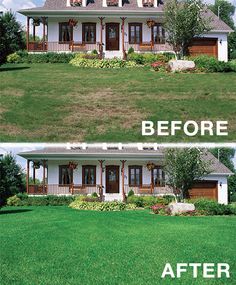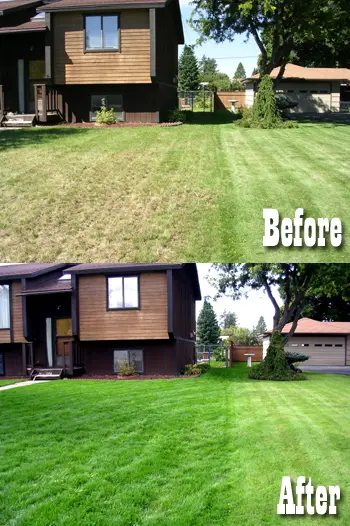We all love a beautiful lawn but harsh weather and overuse can sometimes leave the soil lacking in much-needed nutrients. So when should you feed the lawn to ensure the grass stays lush and healthy?
The timing and regularity of lawn fertilization greatly depends on the type of grass growing on it. Typically grass, and other plants, require feeding during their growth periods, when they deplete nutrients and nitrogen in the soil. Late spring and summer is often the best times to use fertilizer on your lawn. However, the timing for fertilization greatly depends on the grass type you have. Warm season grass and cool season grass should be fertilized at different times. Let’s take a look at the very best time to do this and see how often it should be done.
Table of Contents
Timing is Important
Fertilization of plants is only effective when grass and plants are in their growth cycle.
If you use fertilizer on grass and plants when they are in a dormant growth phase then the fertilizer will have zero effect and you will have simply wasted your time, your fertilizer and your money.
It is only when the grass is growing does it absorb the nutrients and nitrogen in the soil as food.
Grass Type
Although most people will start fertilizing their lawn in spring or summer the fertilization times actually depend very heavily on the grass type that you have growing on your lawn.
There are two grass types:
- Warm season grass
- Cool season grass
Warm season grass should not be fertilized at the same time as cool season grass.
 They both have their own time-table for growth.
They both have their own time-table for growth.
Fertilizing Warm Season Grass
Warm season grasses are so named because they grow rapidly during the warmer months around late spring and summer.
Typically it is a good idea to fertilize warm season grass types from late spring to early fall when growth is occurring.
Try to avoid fertilizing the lawn too early as you will only feed cool season weeds and give yourself a de-weeding problem.
Similarly you should avoid fertilizing too late as your grass will have exited its growth phase and it will then be more susceptible to winter injury.
You should aim to fertilize warm season grass in the warmer months of late spring and summer.
Examples of warm season grass:
- Bahia grass (Paspalum notatum)
- Bermuda grass (Cynodon dactylon)
- Buffalo grass (Buchloe dactyloides)
- Centipede grass (Eremochloa ophiuroides)
- St. Augustine grass (Stenotaphrum secundatum)
- Zoysia grass (Zoysia japonica, etc.)
Fertilizing Cool Season Grass
As the name suggests cool season grasses grow rapidly during the cooler months – usually around fall and early spring.
In areas of the country that have fairly mild winters, such as Florida and southern California, cool season grass has been known to continue growing throughout the entire winter.
You should aim to fertilize cool season grass in the cooler months of fall and early spring.
 It is usually important to ensure you fertilize cool season grass in the fall as the temperature begins to drop as this will keep the grass growing for longer and give it much needed nutrient reserves for an earlier spring growth.
It is usually important to ensure you fertilize cool season grass in the fall as the temperature begins to drop as this will keep the grass growing for longer and give it much needed nutrient reserves for an earlier spring growth.
By fertilizing in the fall you also avoid the problem of limited root growth that can occur if you fertilize in early spring. The grass can look lush and healthy but the root system will have been robbed of the nutrients that created that lush look.
Much better to fertilize in fall and allow the grass to use that store of nutrients and nitrogen to develop strong roots in the spring.
Examples of cool season grass:
- Bentgrass
- Kentucky bluegrass
- Rough bluegrass
- Fine fescue
- Tall fescue
- Creeping fescue
- Annual ryegrass
- Perennial ryegrass
Use Appropriate Fertilizer
Regardless of the time of year that you must feed your grass be sure to use a proper lawn fertilizer that gives the grass the nutrients it needs with nothing else added.
Many cheap fertilizers have bio-solids and other “filler” ingredients meant to bulk out the packet rather than feed your lawn.
Always go for a plant-based solution and try to avoid chemical fertilizer as it can lead to burning and is just not god for the environment overall.

How Often Should You Fertilize?
Making sure you are only fertilizing your lawn in the proper season dependent on its grass type (see above) fertilize it on average every 6 weeks.
By apply fertilization every 6 weeks during the growing the season you will ensure your lawn maintains nice lush healthy looking grass.
This also ensures that your lawn gets all the nitrogen and nutrients that the grass needs throughout the entire growing season.
It is during the growth seasons that your lawn’s soil is very heavily taxed of resources. As the grass grows it depletes the nutrients in the soil and so it is necessary to replace them.
This is why it is so important to use a good fertilizer and not just the cheapest option.
If every 6 weeks is too strict a time-table for you then you can fertilize 1 or 2 times during the spring and 2 or 3 times in the fall for cool season grass.
However, for warm season season grass fertilize at least 3 times over the summer and once in late spring or early fall if the weather is still warm.
Also consider overseeding especially if you have patchy dry areas on the lawn though you may need to scarify/de-thatch and aerate it first.

De-Thatch and Aerate
It is always a good idea to dethatch your lawn and aerate it at least once per year.
There are specific times for aerating and you should be mindful of these or you will run the risk of damaging your lawn should you do it at the wrong time.
Aeration is vitally important for the healthy upkeep of your lawn. If you fail to de-thatch and aerate then sooner or later your lawn will show the signs of this neglect.
If you don’t aerate your lawn then you can use all the fertilizer in the world and the nutrients will simply not reach the roots of the grass. Soon you will have huge patches of dried and dead grass and probably large indentations in the ground.
During the winter your lawn will also get waterlogged in parts and fixing it will just become that much bigger of a job.
Aeration is a very easy thing to do by hand or by machine or even foot tool but doing it could be the difference between a healthy lawn and a big job trying to fix an unhealthy one later down the line.


